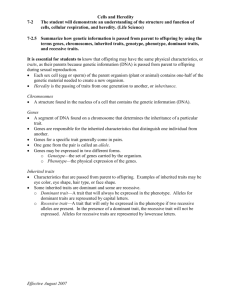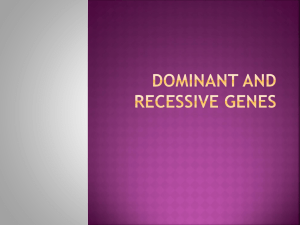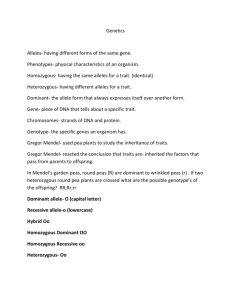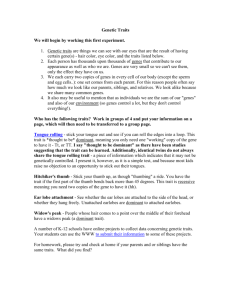Genetics Notes
advertisement
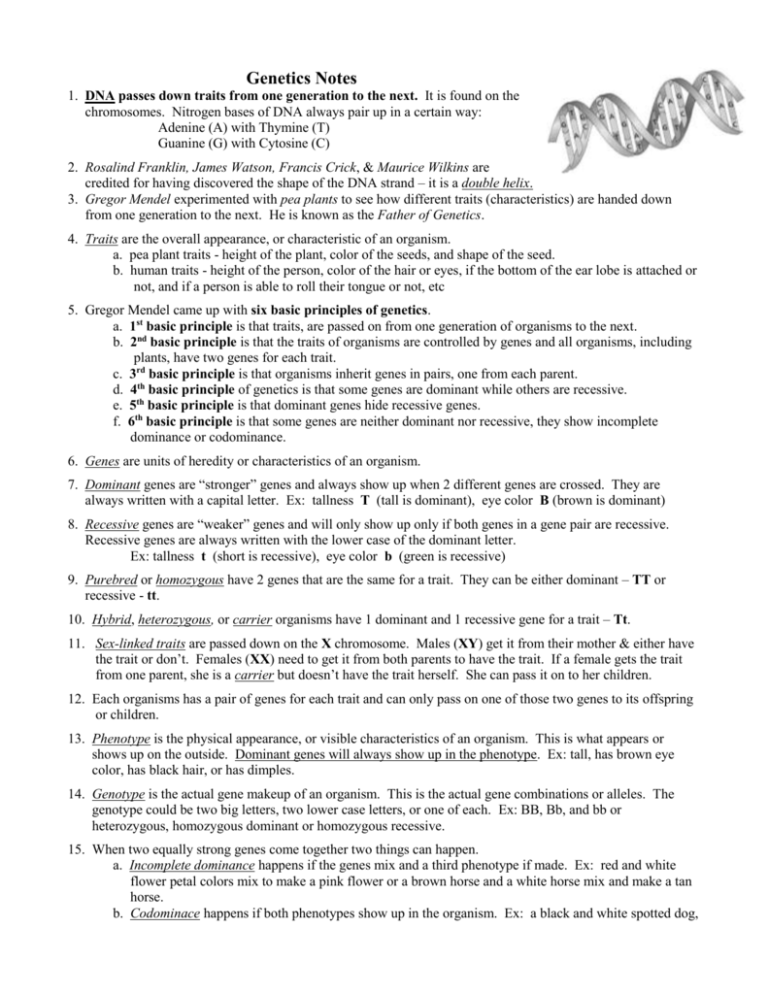
Genetics Notes 1. DNA passes down traits from one generation to the next. It is found on the chromosomes. Nitrogen bases of DNA always pair up in a certain way: Adenine (A) with Thymine (T) Guanine (G) with Cytosine (C) 2. Rosalind Franklin, James Watson, Francis Crick, & Maurice Wilkins are credited for having discovered the shape of the DNA strand – it is a double helix. 3. Gregor Mendel experimented with pea plants to see how different traits (characteristics) are handed down from one generation to the next. He is known as the Father of Genetics. 4. Traits are the overall appearance, or characteristic of an organism. a. pea plant traits - height of the plant, color of the seeds, and shape of the seed. b. human traits - height of the person, color of the hair or eyes, if the bottom of the ear lobe is attached or not, and if a person is able to roll their tongue or not, etc 5. Gregor Mendel came up with six basic principles of genetics. a. 1st basic principle is that traits, are passed on from one generation of organisms to the next. b. 2nd basic principle is that the traits of organisms are controlled by genes and all organisms, including plants, have two genes for each trait. c. 3rd basic principle is that organisms inherit genes in pairs, one from each parent. d. 4th basic principle of genetics is that some genes are dominant while others are recessive. e. 5th basic principle is that dominant genes hide recessive genes. f. 6th basic principle is that some genes are neither dominant nor recessive, they show incomplete dominance or codominance. 6. Genes are units of heredity or characteristics of an organism. 7. Dominant genes are “stronger” genes and always show up when 2 different genes are crossed. They are always written with a capital letter. Ex: tallness T (tall is dominant), eye color B (brown is dominant) 8. Recessive genes are “weaker” genes and will only show up only if both genes in a gene pair are recessive. Recessive genes are always written with the lower case of the dominant letter. Ex: tallness t (short is recessive), eye color b (green is recessive) 9. Purebred or homozygous have 2 genes that are the same for a trait. They can be either dominant – TT or recessive - tt. 10. Hybrid, heterozygous, or carrier organisms have 1 dominant and 1 recessive gene for a trait – Tt. 11. Sex-linked traits are passed down on the X chromosome. Males (XY) get it from their mother & either have the trait or don’t. Females (XX) need to get it from both parents to have the trait. If a female gets the trait from one parent, she is a carrier but doesn’t have the trait herself. She can pass it on to her children. 12. Each organisms has a pair of genes for each trait and can only pass on one of those two genes to its offspring or children. 13. Phenotype is the physical appearance, or visible characteristics of an organism. This is what appears or shows up on the outside. Dominant genes will always show up in the phenotype. Ex: tall, has brown eye color, has black hair, or has dimples. 14. Genotype is the actual gene makeup of an organism. This is the actual gene combinations or alleles. The genotype could be two big letters, two lower case letters, or one of each. Ex: BB, Bb, and bb or heterozygous, homozygous dominant or homozygous recessive. 15. When two equally strong genes come together two things can happen. a. Incomplete dominance happens if the genes mix and a third phenotype if made. Ex: red and white flower petal colors mix to make a pink flower or a brown horse and a white horse mix and make a tan horse. b. Codominace happens if both phenotypes show up in the organism. Ex: a black and white spotted dog, or a human with two different eye colors 16. The law of segregation is where one gene from each pair goes to each gamete, or sex cell (sperm/egg cell). This makes sure that the offspring have the correct number of chromosomes when the gamete cells combine to form the zygote, or fertilized egg cell. 17. The law of independent assortment says that each gene pair for a trait is inherited independently of the gene pairs for all other traits (your hair color is not dependent on your height or eye color; the way you look does depend on the way your brothers and sisters look). 18. Cross-pollination is the transfer of pollen from the stamen of one flower to the pistil of a different flower. 19. P1 is the parent generation F1 is the 2nd generation or what is made when the P1 generation is crossed F2 is the 3rd generation or what is made when the F1 generation is crossed F3 is the 4th generation or what is made when the F2 generation is crossed and so on. 20. Probability is the possibility that an event may or may not take place. It is used in genetics to predict the results of genetic crosses or what the kids look like when two parent have a child. 21. In probability, the results of one event don’t affect the results of the next and previous events don’t affect future ones. (If two people have a tall kid with blue eyes one year, that doesn’t affect how tall or the eye color of the next kid or an earlier one). 22. Punnett squares are used to show the possible gene combinations in a cross between 2 organisms. They show 4 different possible outcomes but it DOES NOT mean that there will be 4 offspring! 23. Each box in the Punnett square represents a possible gene pair in the fertilized egg. G – green color pea plant; g – yellow color pea plant Punnett Squares P1 generation GG x GG (both have a green phenotype) P1 generation GG x Gg (both have a green phenotype) 100% 100% green homozygous pea plants 50 % P1 generation Gg x Gg (both have a green phenotype) 75% green pea plants 25% yellow pea plants green pea plants 50 % homozygous pea plants heterozygous pea plant P1 generation Gg x gg (Gg - green phenotype; gg - yellow phenotype) 50% green pea plants 50% yellow pea plants 24. Mutation is a natural mistake, or change, in the DNA when it is going through mitosis or meiosis cell division. The mutation will only be passed down to the next generation if it is in a sex cell (sperm cell or egg cell). 25. Genetic Engineering is where a scientist changes the DNA of an organism in some way. This can be done by adding in DNA, taking out DNA, rearranging the DNA in a different order, recombining DNA with something else, or by a number of other different ways.

![Biology Chapter 3 Study Guide Heredity [12/10/2015]](http://s3.studylib.net/store/data/006638861_1-0d9e410b8030ad1b7ef4ddd4e479e8f1-300x300.png)

